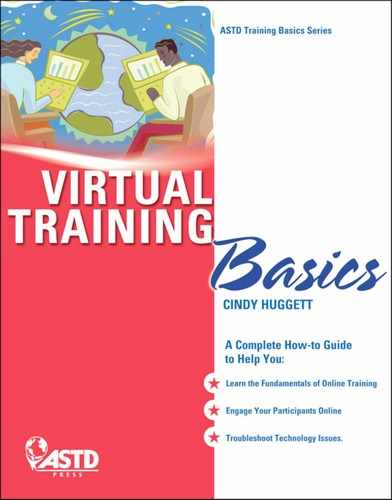Foreword
Only Perfect Practice Makes Perfect
The concept of e-learning in many formats has been around since 1997, as Cindy aptly describes in her first chapter. Age, however, isn't a precursor for maturity, and repetition isn't a synonym for expertise.
So while the training profession is moving into its second decade of "practicing" the concept of e-learning, and more specifically virtual learning, few of us have been "perfecting" our design and delivery. As Vince Lombardi said, "Practice does not make perfect. Only perfect practice makes perfect." Cindy gives us the tools in this book to begin to perfect our virtual training skills.
Why is this important? Most organizations are seeing an increase in the use of virtual training. Travel restrictions, budget cuts, and an increasingly technology-savvy workforce have led most organizations to rethink how they continue to meet the learning needs of their employees. Organizations are asking their trainers to deliver more content online. Trainers are expected to have the skills to design and deliver virtual training.
Unfortunately, the concept of virtual learning is still not very well understood by either organizations or practitioners. Virtual training often falls short of the quality standards expected in traditional settings. Most of these instances are due to a lack of appropriate design and limited knowledge of the skill variations required. It seems that many are still under the misperception that virtual training is simply classroom training set to a different tune. Although almost anything can be taught virtually, those who design and deliver training have not always attended to the translation considerations for both the material and the delivery skills required. Cindy addresses these differences in a way that every reader will understand.
Too often I pick up a book about technology that is way over my head. I may be lost while reading the first chapter! The most unique aspect of this book is that it doesn't assume the reader knows anything about virtual training. It starts with the basics, including definitions and explanations of the necessary hardware and software. It walks us through every aspect of virtual training, from how to set up for a class, to what the trainer needs to know about technology, to what to do when everything goes wrong.
Cindy convinces us that virtual training is "still training" and requires us to tap into all the good things we do in the classroom. And she takes it one step further. She addresses the differences between classroom and virtual training, providing techniques to address the differences. Not only is this practical, but it gives us a calming sense of "I can do that!"
I remember the first virtual training that I conducted. It took me quite some time after it was over to realize that I had treated the session differently. I had thrown out many of the basics of good training, such as facilitating discussion and engaging participants, just because the participants were not in the same room with me. One of the greatest concerns for trainers is that they cannot "see" the participants. One of the most valuable aspects of this book is that Cindy describes other methods of "observing" participants that are available to the virtual trainer. There are ways to "see" your participants. I sure wish I had read this book before my first virtual training session!
Throughout the book, Cindy combines her experience with the experience of other training colleagues. She uses other virtual trainers' quotes to share tips and lessons learned. What I loved about these quotes is that they often present varying views. So even if her colleagues have a different approach from Cindy's, she presents both sides and allows readers to select what will work best for them. The 10 steps in this guide will prepare you better than any other book I've read for your role as a virtual trainer.
If you are searching for professional development that is practical, enabling you to put it to use immediately, you have found the right book. Spend the weekend reading and you'll be a more knowledgeable virtual trainer by Monday. The book is chock full of worksheets, activities, basic rules, assessments, and checklists that ensure ease of understanding and implementing the concepts.
Here's a sample of the topics I found most helpful to perfect my virtual training skills:
- managing your virtual classroom time
- engaging participants in the virtual classroom
- juggling all the elements of virtual training and advice for multitasking
- asking well-thought-out questions
- giving instructions for group activities
- using your voice and speaking skills to enhance the participants' learning.
Cindy personalizes each of the topics through stories that illustrate her advice, making your learning come alive. You will feel as if she is writing directly to you when she asks a question you've been thinking about or when she highlights one of her slipups that matches one of your fears. This is Cindy's way of telling us that she has been there, too. She illuminates our learning by taking us by the hand and walking us through each of the concepts in her reassuring way.
The best reason for any product is to fill a need and Cindy has done that with this book. I don't think there is anything on the market that hits the mark quite like Virtual Training Basics. Cindy is an early adopter of technology, starting her training career as a software instructor. She has delivered hundreds of virtual training classes for more than a decade. She is passionate about developing trainers and helping them be the best that they can be. Who better to coach all of us to be better virtual trainers? You are in good hands with this book by your side and Cindy as your guide to perfect your virtual training skills.
